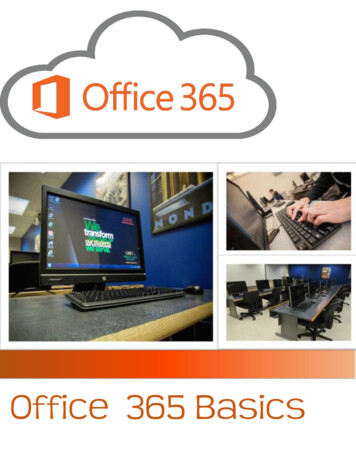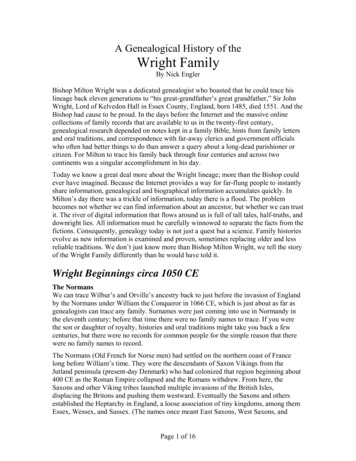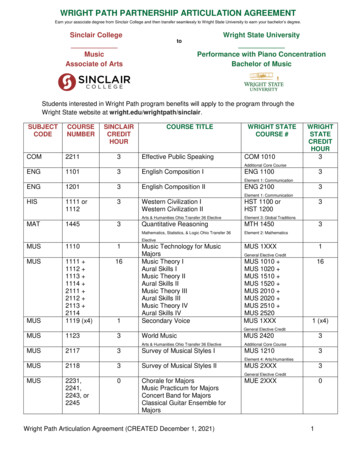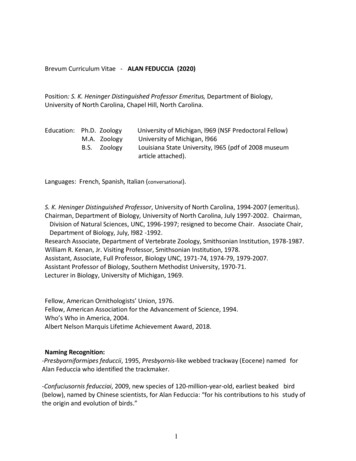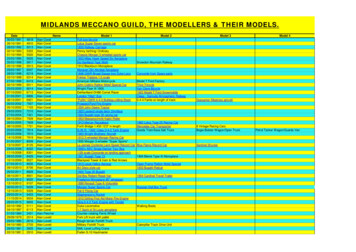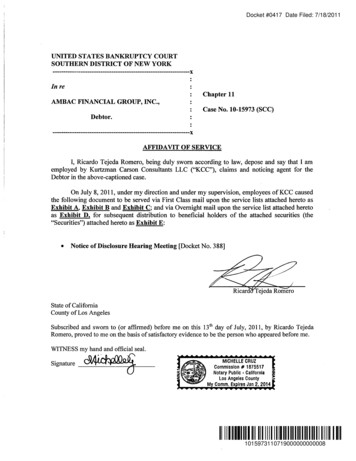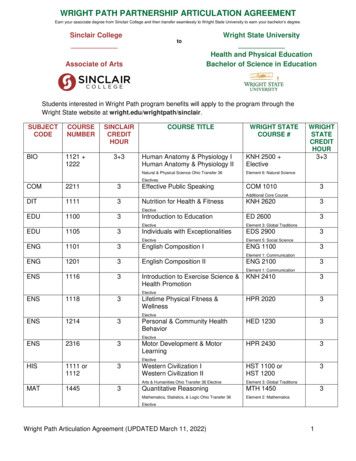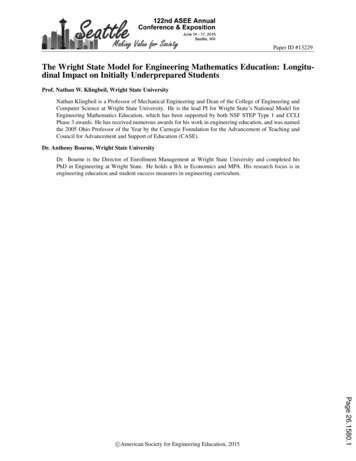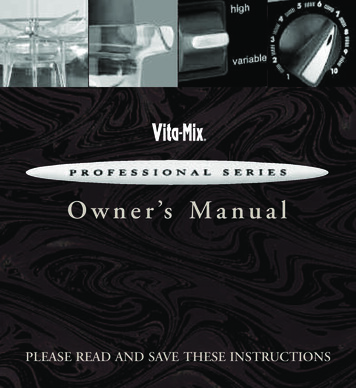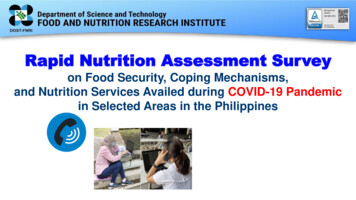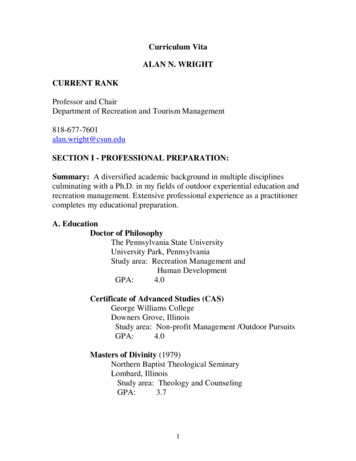
Transcription
Curriculum VitaALAN N. WRIGHTCURRENT RANKProfessor and ChairDepartment of Recreation and Tourism Management818-677-7601alan.wright@csun.eduSECTION I - PROFESSIONAL PREPARATION:Summary: A diversified academic background in multiple disciplinesculminating with a Ph.D. in my fields of outdoor experiential education andrecreation management. Extensive professional experience as a practitionercompletes my educational preparation.A. EducationDoctor of PhilosophyThe Pennsylvania State UniversityUniversity Park, PennsylvaniaStudy area: Recreation Management andHuman DevelopmentGPA:4.0Certificate of Advanced Studies (CAS)George Williams CollegeDowners Grove, IllinoisStudy area: Non-profit Management /Outdoor PursuitsGPA:4.0Masters of Divinity (1979)Northern Baptist Theological SeminaryLombard, IllinoisStudy area: Theology and CounselingGPA:3.71
Bachelor of Arts (1976)Gordon CollegeWenham, MassachusettsStudy area: Liberal Studies and Biblical StudiesGPA:3.4B. Professional ExperienceProfessor and Chair of Recreation and Tourism ManagementCalifornia State University Northridge (1990-2010)Department of Recreation Hospitality and TourismManagementChair duties include hiring and assignments for faculty. Budgetdevelopment and management for the unit. Strategic planning andprogram growth and development. Fund development. Teaching andstudent advising. Committee work. Thesis committees. Research andpublications.Promotion from Assistant to Associate to Full Professor while atNorthridge. Currently serve as the Chair of the Department.Department has a student FTE enrollment of 250 (Full TimeEquivalent) and a Faculty FTE of 11 (50% tenure track).Undergraduate program growth of is significant as well as graduateprogram resurgence. New curriculum initiatives completed andunderway. Negotiated degree name change. Accreditation self-studyand strategic plan.Previously served as Outdoor Coordinator with administrativeresponsibilities for the outdoor recreation curriculum and relatedoutdoor programs in the department.Vice President of Development and Leadership InstitutesGreen Lake Conference CenterProfessional Leave Project: (2004-2006)In the fall of 2004 began a professional leave of absence fromNorthridge to work directly with a Christian non-profit with2
responsibilities in fund development & leadership development. Thecenterpiece of the project was managing a 2 million dollar grant fromthe Lilly Endowment to train clergy and congregational teams inleadership and organizational transformation. Details of this projectare listed later in the vita under professional contributions.Professional Experience Prior to Current Review PeriodLand Use Planning Consultant Harrison, Hempe, & Davis, Inc.1990 - 1996Camp Planning/Development ConsultantsAssociate consultant with the firm on project basis. Projectsincluded long range land use plans for youth camp facilities,feasibility studies, and customer relations.Executive Director1983 - 1990Canonicus Camp and Conference CenterExeter, Rhode IslandCanonicus is a non-profit Christian agency providing programs andservices to youth, families, and adults. Executive Director wasresponsible for all aspects of the center’s operation. Majorachievements included.o Fund Raising: Increased annual contributions by eightfoldduring my tenure of leadership. Directed a capitalcampaign to a successful conclusion of 1.1 million.Initiated planned giving program.o Property Development: Supervised the development of acomprehensive long range land use plan for the facility.Served in the developer role working with architects andengineers for design and construction of five new buildings,activity centers, new water system, new roads, & utilities.Negotiated with government agencies for permits andcertificates.o Operations Management: Supervised all budgets in thecapital development (1.5 M) as well as the operationalbudget. Operational funds tripled in six years. Increased3
youth program attendance by 160% (430 to 1150 campers)and family use by 130% (3000 to 7000 user days) throughquality program development and creative marketingstrategies.Instructor1980-1982Senior Instructor1977-1982SeasonalThe Pennsylvania State UniversityRecreation, Park and TourismManagement DepartmentAdventure Program OrganizationsServed as Senior Instructor for a varietyof outdoor organizations including OutwardBound. Many of these courses worked withyouth-at-risk.SECTION II: TEACHING EFFECTIVENESSSummary: Teaching effectiveness in the classroom documented bypositive student evaluations (means scores of 4.5 out of 5) andpositive peer reviews.A. Classes TaughtHave taught a wide variety of classes in RTM department (18) duringperiod of review covering area of specialization, general core of thedepartment, and GE and service classes to the university. Greatestamount of teaching time spent with multicultural education (RTM310), environmental/outdoor education (RTM 151, 251, 351),leadership development (RTM 302), marketing (RTM 303, RTM550), and management (RTM 304, 444, 620). Classes taught include:RTM 620 Organizational Theory (Graduate Course)RTM 550 Marketing for Tourism and Rec Sport (Grad Course)RTM 444 Nonprofit Management and Fund Development (3)RTM 310 Adventure Recreation & Human Relations (3)RTM 304 Entrepreneurial Ventures in Recreationand Human Services (3)RTM 303 Promotion & Marketing of Recreation Programs (3)4
RTM 302 Dynamics of Leadership in Recreationand Human Services (3)RTM 300 Community and Youth Development (3)RTM 351 Practices of Outdoor Education (3)RTM 251 Recreation and the Natural Environment (3)RTM 151 Intro to Backcountry & Outdoor Education (1)RTM 151 A Backpacking (2)RTM 151 B Rock climbing and Mountaineering (2)RTM 151 C Winter Mountaineering (2)RTM 151 D Quiet Water (2)RTM 151 F Wilderness Survival (2)RTM 151 G Challenge/Ropes Courses (2)RTM 151 H Caving (2)B. Student Evaluations of TeachingConsistently high student evaluations of teacher effectiveness arereported. Mean quantitative scores of 4.5 on 1-5 scale. Cumulativescores are available upon request.C. Faculty Evaluations of TeachingConsistently positive evaluations of teacher effectiveness bycolleagues are reported. Summary of peer evaluations are availableupon request.D. New Technologies & Experimental Teaching Methods:Consistently increased knowledge and expertise in application of newtechnologies to the educational process. Work in this area hasincluded the following:Attended workshops sponsored by the university for application oftechnology to the classroom setting: Web design and WebCT,Moodle (2008), new online classroom software Elluminate(2007).Developed web based modules for the RTM 310 AdventureRecreation class in 1999; ‘web based promotion module’ in RTM304 Promotion and Marketing class; full on-line class5
development for RTM 150 (2011), RTM 251 (2006) and RTM151 (2002).Video tape instructional aide produced with support fromInstructional Media Laboratory for use in RTM 351 Practices ofOutdoor Education.E. Undergraduate Advisement & Thesis CommitteesActive involvement as advisor of undergraduate majors in thedepartment.Graduate student involvement with participation and/or advisoron Master’s thesis in the departmentAlso mentored undergraduate Teaching Assistants in outdoorfield classes each semester.SECTION III: SERVICE TO THE UNIVERSITY AND COMMUNITYSummary: University service is more broadly defined than service in thefaculty committee structure at various levels of the campus. Though serviceon committees is noted for the period of review the much greater level ofservice has been in development and management of several key projects.The key projects were highly consistent with university goals and initiativesexpressed at the university and college level.A. Recreation and Tourism Management Department Projects:Curriculum DevelopmentRedeveloped Outdoor Recreation curriculum in 1996 andmoved through curriculum approval process.Chairperson of Department Curriculum Committee 1994-2004.Return to Chair of Curriculum Committee for Department from2006- present.6
Curriculum Reorganization: Served as facilitator for majorcurriculum revision process from Spring 1999- Spring 2000.Assisted faculty with team development as foundation to reinventing overall department curriculum.Curriculum Expansion: worked with faculty to develop newundergraduate curriculum initiatives in HospitalityManagement, new Minor in Leadership, and new onlineMasters program in Tourism and Hospitality Management.Department Web PageWorked to establish and then upgrade initial department webpage. Served as webmaster from 1999-2003. Current webdisaster not connected.Department Personnel CommitteeChair person of personnel committee 1996-1997; 2009-2010.Outdoor CoordinatorAs outdoor coordinator for the department from 1990-2004reviewed all off-campus trip programs for compliance with oursafety management program and worked to recruit and trainpart time instructors (5) and student assistants for safeoperation of curricular and co-curricular programs.Special Department ProjectsWilderness Connections and Adventure Learning Center weredepartment sponsored projects designed to serve university andcommunity goals as well as departmental goals and are listed inuniversity service section.Challenge Ropes Course: A new high ropes course wasinstalled on the CSUN campus in 2004. The state of the artfacility includes universal design features (ADA) and is valuedat 85,000 and was installed by Dr. Wright and studentassistants for a direct cost of 38,000. The course continues to7
be used for curricular and co-curricular instruction and replacedthe course Dr. Wright built in 1991.AEE Accreditation: The RTM outdoor program pursuedaccreditation by the Association for Experiential Education inthe 2003-04 academic year. The self study was authored by Dr.Wright with input from part-time outdoor faculty in 2003 andthe on-site accreditation visit was conducted in 2004. Thereview was overwhelmingly positive by the AEE accreditationteam with a positive compliance percentage of 96% .B. College of Health and Human Development CommitteesHHD Curriculum CommitteeCommittee assignment 2000-2002; 2007 – present.Created proposal in 2011 to revise curriculum review processfor the campus. Under consideration 2011-12.HHD Awards CommitteeCommittee assignment Fall 1994 - Spring 1997.HHD Technology CommitteeCommittee assignment Fall 2000 – Spring 2001.C. University CommitteesFaculty SenateTwo year term as Senator. Fall 1998 - Spring 2000.Scholarship Selection CommitteeCommittee assignment. Fall 1994 - Spring 1997.D. Special Projects Serving University and External CommunitiesNew Student Orientation Program – Wilderness ConnectionsDeveloped new initiative for incoming students at the Universitycalled ‘Wilderness Connections’ in Fall 2001 and 2002. Program wasdesigned to foster student success and retention at the university inalignment with university goals.8
Program was promoted in collaboration with EOP staff across campusand with assistance from Undergraduate Studies. Dr. Wrightcoordinated all these efforts and designed and supervised thewilderness program in the High Sierra. Student evaluation of theprogram was excellent.Adventure Learning CenterThis major project aligned with university goals in externalcommunity service and increasing resources as well as addressingcollege goals of creating a learning-centered environment and focuson student’s professional preparation.The Adventure Learning Center began in 1996 and was designed tocreate service learning opportunities for students while servingvarious agencies with direct programs in leadership, teamwork, andpersonal growth through adventure education. From 1996-2004, thecenter providedo over 2600 hours of service learning experiences for studentso served over 75 community organizationso generated over 200,000 in revenueo served 14,000 participantso and created a tertiary impact of over 70,000 annually throughthe train-the-leaders concept.The center provided direct services to many non-profit and corporateclients and also trained agencies to create internal adventure educationcenters. Major projects included installing the first adventure coursefor LA City Recreation and Parks Department and first adventurelearning center in LA Unified School District. The Patrick HenryMiddle School (LAUSD) became a model program for middle schoolPE with their adventure learning center. A summary report of thismajor project is available upon request.Community Service Leave 2004-2006In the fall of 2004 began a professional leave of absence fromNorthridge to work directly with a non-profit organization with9
responsibilities in fund development & leadership development, inaddition to work on writing projects.The leave was designed to enrich my professional emphasis areas aswell as serve the external community. Outcomes and duties aresummarized quickly below.Supervised the fund development department of Green LakeConference Center. Green Lake is a small religious non-profitorganization providing educational programs in leadershipdevelopment and youth development. Responsibilities includeddonor relationships, annual and capital giving, planned giving, datamanagement, staff supervision, and special event fundraising. Thiswork was consistent with my teaching RTM 444 NonprofitManagement and RTM 302 Leadership.o In 2004 gifts at the center totaled 2.2 million for bothannual and capital giving. The annual fund showed anincrease in 2005 of 120% based mostly on a key new donorgift of 500,000.o In 2005 initiated a project with marketing and guest servicesto integrate new customer information with the donordatabase system. New procedures resulted in significantability to capture new donor prospects.o Research on the current donor profile of the organizationbecame the basis of the newly generated strategic plan forthe development department.The conference center was awarded a 2 million dollar grant as part ofthe Sustaining Pastoral Excellence initiative by the Lilly Endowment.The ecumenical leadership project was named the Center forExcellence in Congregational Leadership (CECL). As projectmanager supervised the 2 million dollar grant budget and programdesign and delivery. The grant opportunity was the primary reason forthe professional leave. Additional detail on the Lilly project is listedunder contributions to the field of study.10
Supervised two other leadership development initiatives in addition tothe Lilly grant.o Worked with a team to create a new Coaching Center for GreenLake Conference Center providing training in coachingmethodology for leadership development and teamdevelopment. Worked specifically with Jane Creswell as thelead coach/consultant for initiating the center. Jane is a formerexecutive with IBM and founder of the IBM Coaches Network,a group of 200 coaches over 8 continents. The coachingcurriculum is certified as meeting educational requirementsleading to Coaching Certification by the International CoachingFederation which is the leading professional organization in thecoaching field.o An Institute for Camp and Conference Ministries had beendeveloped previously at the center by Dr. Wright and a team ofcolleagues in 2000. The Institute focuses on organizationalchange and leadership excellence and I continued to serve asthe team leader in 2004-05. This project is discussed at greaterlength in the professional contributions section.SECTION IV - CONTRIBUTIONS TO THE FIELD OFRECREATION AND TOURISM MANAGEMENTSummary: The contributions to the field demonstrate both a clear historyand on-going plan for publications (15 publications with 8 refereedarticles/equivalents) over my career at CSUN.Beyond a publication count, the department and the university have movedtoward a broader view of scholarship and contributions to the field of study.The argument supporting this broad view is based on Ernest L. Boyer’sseminal work, Scholarship Reconsidered: Priorities of the Professoriate(1990) where he delineates the scholarship of discovery; the scholarship ofintegration; the scholarship of application; and the scholarship of teachingIn addition to the original research and scholarship of discovery &integration reflected in the publication list, part of my scholarship hasfocused on the scholarship of teaching as represented on the collection and11
analysis of teaching outcomes for one class in particular: Human Relationsand Adventure Recreation (RTM 310). Details are provided in Section IVC.The scholarship of application represents a major part of my professionalcontribution and is discussed in Section IV-D with evidence submitted ontwo major projects. Dr. Wright’s direct involvement in training andconsulting in the field is also broad evidence of his strength as one whointegrates theory with practice and then develops partnerships and teachingopportunities with agencies in the field. A summary of the extensive list ofpresentations and consultations follows after the publications section.Dr. Wright’s full record of scholarship is characterized by pioneering workin five different examples:o New approaches in the discipline. The theory paper on application of adventure educationmethods to multicultural education was the firstpublished in this area of the discipline (Wright, 1994). The work in specific self-concept (versus global selfconcept) to assess outdoor education impact (Wright1978, Wright 1996) was the first in the literature andcontinues to be cited in the field.o The scholarship of application represented by the Camp Institute isviewed by industry executives as unique and a representation of acreative response to the critical needs of the camping industry.o The scholarship of application represented in the Lilly project is apioneering project in its curriculum design and documented outcomesin leadership development and organizational change strategies forchurches.o The book project linking team effectiveness to team member valuesand spirituality also demonstrates pioneering work.The final point of summary of my scholarship is to recognize the diversenature of the subject matter as well as the consistency of certain threads ofresearch. The general umbrella of my work is asking the question of the12
programmatic impact of experiential education on individuals and groups(from experiential designs that use outdoor climbing adventures to coachingmethods). Within that umbrella there are studies that tie directly toindividual impacts (e.g. personal self-confidence, leadership effectiveness),team outcomes (e.g. book publication and training programs), andorganizational impacts (e.g. design of transformation programs). Theseresearch areas tie consistently to classes taught in the department.Scholarship Evidence:A. Publications in Preparation (Scholarship of Discovery &Integration)Building Bridges: an experiential approach to increase multi-culturalunderstanding. Manuscript in preparation.Learning Outcomes from an Adventure-based Multicultural EducationProgram.Abstract accepted and poster session presented for Coalition forEducation in the Outdoors, Indiana University, January 2010.This study used a computerized text analysis of student essays toassess learning outcomes from a university class in multiculturaleducation. Results show positive outcomes in self-confidence, groupexperience, diversity awareness, and prejudice reduction. (Refereedpresentation. Full article for journal publication in preparation)B. Publications (Scholarship of Discovery & Integration)Spiritual Dimensions of Team was published by Chalice Press andreleased in August 2010. The book provides a model for teams tobecome self-directed high performance teams. The work exploresfunctional dimensions of team and how human values and spiritualityimpact functional dimensions. Refereed publication."Prejudice Reduction through Shared Adventure: QualitativeOutcome Assessment of Multicultural Education Class" has beenpublished by the Journal of Experiential Education. Fall 2009.13
The study is a qualitative empirical study based on content analysis offive years of student reported impact from the RTM 310 multiculturaleducation class. Refereed publication.“Jubilee: the great adjustment: Trends and issues for camp &conference centers” Baptist Leader, Spring 1998, 20-21. Non-refereed– invitation by editor.“Camps and conference centers can help the local church experiencejubilee” Baptist Leader, Summer 1998, 21. Non-refereed – invitationby editor."The Permanency of a Specific Self Concept: The Long Term Effectsof a Positive Experience of the Self." Coalition for Education in theOutdoors Third Biennial Research Symposium. ed. Leo McAvoy.Cortland, NY: Coalition for Education in the Outdoors, 1996.Refereed publication.“Will there be Land for the Next Generation of Camp and ConferenceCenters” Journal of Christian Camping. April 1996."Multicultural Education through Shared Adventure" in Coalition forEducation in the Outdoors Second Biennial Outdoors ResearchSymposium. ed. Leo McAvoy. Cortland, NY: Coalition forEducation in the Outdoors, 1994. Refereed publication."Impact Surfaces for Low Components in Challenge Courses" inProceedings from the 1993 Association For Challenge CourseTechnology Symposium. Ed. Mike Fischesser. Jonas Ridge, NC:Alpine Towers, Inc., 1993“Planned Giving Programs: The New Frontier for Leisure ServiceOrganizations.” Journal of Physical Education, Recreation, andDance. October 1991, 62 (8), 35-39. Refereed publication.“Strategies for Teaching Problem-Solving Skills to Troubled Youth”in Wilderness Challenge: Outdoor Alternatives for Youth in Need,eds. Douglass P. Teschner and John J. Wolter. Hadlyme, CT:Institute of Experiential Studies, 1984.14
Youth Development through Outdoor Adventure Programs. Chicago:Fund for Advancement of Camping, 1983. Refereed publication.“Therapeutic Potential of the Outward Bound Process: An Evaluationof a Treatment Program for Juvenile Delinquents. TherapeuticRecreation Journal. 1983, 17(2), 33-42. Refereed publication.“The Effect of High Adventure Activities on Adolescent SelfConcept: A Comparison of Situationally Specific Self-ConceptMeasurements with Global Self-Concept Measurements." Resourcesin Education, 1983, 18 (4), ED 224-791. Paper presented at theNational Convention of American Camping Association (1982).Challenge Course Instructor's Manual. State College, PA: ThePennsylvania State University, 1981.Leisure Research Abstracts 1979 (with Patricia Farrell). Arlington,VA: National Recreation and Park Association, 1980.D. Scholarship of TeachingThe RTM 310 Adventure Recreation and Human Relations class has becomea field of investigation to assess whether adventure education methodsimpact student views related to personal identity and cultural diversity. Thequalitative research project has identified positive outcomes in several areasas it examined 134 students representing various class sections over a fiveyear period.Outcomes include: positive outcomes in personal identity, group experience,diversity awareness, and prejudice reduction. Students also indicatedtransfer-of-learning to non-classroom contexts. The assessment reportedstatistically significant relationships between diversity outcomes and specificexperiential learning events and was published in the Journal of ExperientialEducation (2009)E. Scholarship of ApplicationThe scholarship of application asks the question "How can knowledge beresponsibly applied to consequential problems? How can it be helpful toindividuals as well as institutions?” (Boyer 1990, p. 21). Boyer suggests15
that for service activities to be seen as scholarship they should be related toone’s field of knowledge and be characterized by rigor and accountability.My scholarship of application is represented by over 170 consultations withmy industry groups and over 55 presentations at professional conferencesand they are summarized in Section IV-E-3 of the vita.One can not take the time to assess all the demonstrations of scholarship ofapplication. Two major projects in my scholarship of application are theInstitute for Camp and Conference Ministries and the Lilly grant projectcalled, CECL. Both are described here and the documented evidence ofexcellence and measurable outcomes is available upon request.Consultations and presentations are the third indicator of a strongscholarship of application.1. Lilly Project: Center for Excellence in Congregational LeadershipThe Lilly Endowment funded a major national initiative entitled SustainingPastoral Excellence. The Green Lake Conference Center was awarded a 2million dollar grant from that competition. The grant represented anecumenical partnership between five evangelical Christian denominations inthe upper Midwest with the goals of increasing leadership effectiveness incongregations and to create healthier congregations.Dr. Wright served as the Director of the program and was responsible forcurriculum design, training event planning, staff training, conferencecoordination, marketing, and budget management.The following three sources validate the success of this scholarship ofapplication in program design and delivery.o The CECL project hired an external project evaluator, Dr. TomWatkins, Ph.D. who is the director of evaluation for St. PaulMinnesota Public Schools. Program outcome examples include:o Clergy leadership from cohort 1 indicated a 36% drop in“likelihood of burn-out” from pre to post testing.o The Natural Church Development scale (a standardizedmeasure of church organizational health) showed significantincreases on goal oriented ministry, holistic small groups,functional structures, and community outreach.16
o Leader’s view of the congregational leadership team “bringingabout change” saw an improvement of 38% from pre to post.o The Lilly Endowment showed its support for the evaluation ofthe project by providing the project with a rare continuationgrant in 2007 for 1 million dollars bringing the total projectsupport to 3 million dollars.o Dr. Wright worked with Dr. Lori Carrell, Professor of Communicationat University Wisconsin, Oshkosh to design a major trainingcomponent on communication effectiveness for clergy. The importantrole of leadership communication in organizational change initiativesis well documented. This part of the CECL curriculum focused onpublic communication through preaching. Dr. Carrell has publishedher findings in both a trade journal and a research journal.2. Institute for Camp and Conference Ministry - Leadership inProfessional GroupThe Institute program launched in January 2000 after a year of planning andpromotion in 1999. Dr. Wright served as the team leader and created theInstitute along with a group of four colleagues. The Institute was organizedbased on the crisis facing agencies in the organized camp movement. Thedesign was based on key issues and values facing this group of organizationsas well as learning principles gathered from the organizational changeliterature. Examples included action based learning, a guiding coalition(team), vision casting, accountability. Individual camp organizations wererecruited to attend the Institute.The Team delivered 27 training conferences across the country from 20002006 and invited presenters who were national experts in their topicsincluding a special 2 hour dialogue seminar at the Harvard Business Schoolwith leadership expert Dr. John Kotter in September of 2000. Dr. Kotter’swork on leading organizational change was a foundational model for theInstitute’s design.Dr. Wright contributed frequently to the conferences as a presenter asreflected in lists of professional presentations.o Outcome measures collected from organizations action plans includepositive changes in fund development, visionary planning, board17
governance, program development, marketing, staff training, andoperations.o Letters of support from the two national associations which servicethe organized camp industry reflect the innovative nature of theprogram.3. Presentations and Consultations are further support of serving theprofession and a demonstration of the scholarship of application.Summary: The lists of presentation to the profession are divided intotwo groups; those workshops or papers presented at a professionalconference or symposia.Professional conference presentations now number over 55. Topics atprofessional conferences have included research papers as well aspractitioner focused workshops on such topics as effective teams,leadership, vision and strategic planning, board governance, funddevelopment, safety and risk management, environmental education,multi-cultural education, marketing, and time management. The fulllisting of presentations is available upon request. The list for the lastsix years is provided at the end of the vita (Letter H).In addition to presentations at professional conferences, there havebeen a large number of presentations and/or consultations for specificorganizations in their context (approximately 170). Consultations canbe grouped in the following categories: group facilitator training(40); safety inspections for adventure facilities (70); buildingeffective teams (23); non-profit board development (6); land-useplanning (18); strategic planning (5); leadership development (4);executive coaching (6); customer service training (2); and funddevelopment (2).Consultation agencies have included participants from all sectors ofthe community from large corporations such as Texaco to smallbusinesses, large government groups such as Los Angeles City,public and private schools such as Los Angeles Unified SchoolDistrict, UCLA, Cal State Fresno and a variety of nonprofit agenciessuch as the YMCA, Campfire, Girl Scouts, Boy Scouts, and manylocal non-profit organizations including churches and para-church18
ministries. Specific documentation with dates and communityorganizations involved are
university service section. Challenge Ropes Course: A new high ropes course was installed on the CSUN campus in 2004. The state of the art facility includes universal design features (ADA) and is valued at 85,000 and was installed by Dr. Wright and student assistants for a direct cost of 38,000. The course continues to
